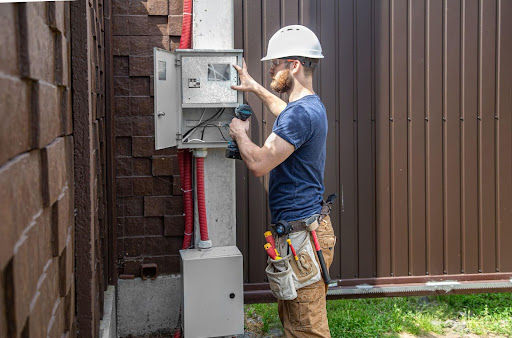Business
What to Expect During Your Professional Generator Installation

Deciding to invest in a backup power system represents an important step toward home energy security. However, many homeowners remain uncertain about what the installation process actually entails. Unlike simpler home improvements, whole house generator installation involves multiple specialized components and systems working together to create seamless power protection. Understanding the installation process helps homeowners prepare appropriately and ensures a smooth experience from decision to completion.
The Pre-Installation Assessment: Creating Your Power Profile
The installation journey begins with a comprehensive assessment conducted by qualified professionals. This critical first step goes far beyond simply selecting a generator size—it creates a complete power profile of your home that guides all subsequent decisions.
During this assessment, expect professionals to:
Analyze Your Electrical Needs:
- Examine your electrical panel and service capacity
- Document critical circuits that must remain powered
- Calculate starting and running wattage requirements
- Identify potential load management opportunities
- Discuss priorities for partial versus whole-house coverage
Evaluate Installation Location Factors:
- Measure clearances from windows, doors, and combustibles
- Assess noise impact on your home and neighbors
- Check accessibility for maintenance and service
- Evaluate proximity to gas lines or propane options
- Consider aesthetics and landscaping integration
Review Local Requirements:
- Research local permit requirements and restrictions
- Identify zoning regulations affecting placement
- Document homeowner association rules where applicable
- Verify compliance with noise ordinances
- Check for special requirements in historic districts
Discuss Fuel Options:
- Assess natural gas availability and pressure
- Calculate propane tank sizing if needed
- Evaluate connection requirements
- Discuss fuel consumption expectations
- Review safety considerations for each option
This assessment typically takes 1-2 hours and results in detailed recommendations tailored to your specific situation rather than generic solutions. The information gathered becomes the foundation for system design, equipment selection, and installation planning.
The Equipment Selection Process: Matching Technology to Needs
Based on the assessment findings, your installation professional will recommend specific equipment configurations. This crucial step involves several important considerations:
Generator Sizing:
- Proper capacity to handle essential loads
- Appropriate headroom for starting surges
- Future expansion capabilities if needed
- Efficiency optimization to prevent oversizing
- Appropriate voltage and phase configuration
Transfer Switch Selection:
- Manual versus automatic operation
- Whole-house versus selected circuit coverage
- Service entrance rated where required
- Smart load management capabilities
- Compatibility with existing electrical systems
Monitoring and Control Systems:
- Basic versus advanced interfaces
- Mobile connectivity options
- Integration with existing home automation
- Self-testing configuration and scheduling
- Maintenance alert systems
Accessory Components:
- Cold weather kits for northern climates
- Advanced sound attenuation packages
- Extended warranty options
- Maintenance packages
- Mounting systems and pads
Quality professionals will explain the rationale behind each recommendation, helping you understand the trade-offs between different options rather than simply pushing the most expensive solutions. This educational approach empowers informed decision-making aligned with both budget and needs.
The Permitting Process: Navigating Regulatory Requirements
Before physical installation begins, various permits and approvals must be secured. This phase often represents the longest timeline component, particularly in municipalities with complex requirements or backlogged review processes.
The permitting process typically includes:
Electrical Permits:
- Documentation of planned electrical modifications
- Compliance verification with electrical codes
- Load calculations and equipment specifications
- Licensed electrician credentials
- Inspection scheduling requirements
Mechanical/Gas Permits:
- Fuel line installation or modification plans
- Pressure testing protocols
- Compliance with gas code requirements
- Ventilation and clearance documentation
- Certified gas fitter credentials
Zoning/Land Use Approvals:
- Setback compliance verification
- Noise ordinance conformity
- Aesthetics requirements in some jurisdictions
- Environmental considerations in sensitive areas
- Homeowner association approval where applicable
While timing varies significantly by location, expect this phase to require anywhere from a few days to several weeks. Experienced installation companies typically handle this process seamlessly, with minimal homeowner involvement beyond required signatures. They maintain relationships with permitting offices and understand local requirements, significantly streamlining what can otherwise be a complex bureaucratic process.
Site Preparation: Creating the Foundation
Once permits are secured, physical preparation begins. This phase establishes the proper foundation and connections for your system:
Concrete Pad Installation:
- Excavation to appropriate depth
- Form construction for precise dimensions
- Reinforcement placement for structural integrity
- Conduit positioning for electrical connections
- Concrete pouring and finishing
- Curing time before equipment placement
Fuel Supply Preparation:
- Natural gas line extension or modification
- Propane tank placement and line installation
- Pressure testing of all connections
- Regulator installation and adjustment
- Safety valve integration
Electrical Service Preparation:
- Conduit installation between pad and home
- Transfer switch mounting location preparation
- Load center modifications where needed
- Grounding system enhancement if required
- Disconnection point installation
These preparations create the infrastructure framework for the generator installation. While some components might appear simple, proper execution significantly impacts system reliability, safety, and longevity. Professional installation ensures these foundational elements meet both code requirements and manufacturer specifications.
Installation Day: Bringing the System Together
With preparations complete, the installation team arrives with your generator and associated components. This phase transforms planning into operational reality:
Equipment Placement:
- Precision positioning on the prepared pad
- Proper leveling and anchoring
- Vibration isolation installation
- Weather protection verification
- Service clearance confirmation
Transfer Switch Installation:
- Mounting in approved location
- Connection to main electrical service
- Integration with critical circuit panels
- Control wiring installation
- Safety disconnection verification
Fuel Connection Completion:
- Final connection to prepared fuel lines
- Leak testing under operating pressure
- Flow verification at required volume
- Compliance inspection for code requirements
- Safety shutdown system testing
Electrical Integration:
- Generator connection to transfer system
- Control circuit completion
- Grounding system integration
- Surge protection implementation
- Load management setup where applicable
Control System Configuration:
- Automatic start parameter programming
- Exercise schedule implementation
- Monitoring system activation
- Alert notifications setup
- Mobile application configuration
This phase typically requires 4-8 hours for standard installations, though complex systems or challenging sites may require additional time. Throughout the process, quality installers maintain communication about progress and any unexpected challenges encountered.
Commissioning and Testing: Verifying Performance
With physical installation complete, the system undergoes comprehensive testing to ensure proper function under all conditions:
No-Load Testing:
- Initial startup verification
- Operating parameter confirmation
- Control system function testing
- Safety shutdown verification
- Noise and vibration assessment
Load Testing:
- Gradual application of electrical load
- Voltage and frequency stability verification
- Transfer timing measurement
- Recovery response evaluation
- Temperature monitoring during operation
Failure Simulation:
- Utility power interruption testing
- Automatic startup verification
- Transfer switch operation confirmation
- Return to utility power testing
- Multiple cycle verification
System Integration Testing:
- HVAC equipment operation under generator power
- Well pump or water system verification
- Electronics compatibility assessment
- Smart home system integration
- Security system function confirmation
This testing process typically requires 1-2 hours but represents one of the most crucial phases. It validates that all components work properly together and identifies any adjustments needed before the system faces a real emergency.
Homeowner Education: Ensuring Long-Term Satisfaction
Before considering the installation complete, quality professionals provide comprehensive education about your new system:
Basic Operation Training:
- Manual operation procedures
- Automatic function explanation
- Control interface navigation
- Mobile application usage
- Indicator light interpretation
Maintenance Requirements:
- Regular inspection checklist
- Owner maintenance responsibilities
- Professional service schedules
- Fluid and filter change procedures
- Exercise cycle explanation
Troubleshooting Basics:
- Common alert interpretation
- Simple reset procedures
- When to call for service
- Emergency shutdown process
- Record-keeping recommendations
Documentation Review:
- Warranty coverage explanation
- Operating manual walkthrough
- Maintenance log setup
- Important contact information
- Parts and service resources
This education phase creates confident homeowners who understand their systems and can optimize performance through proper operation and maintenance. Rather than merely selling equipment, quality installers create informed system owners.
Post-Installation Support: The Ongoing Relationship
The generator installation relationship extends long after initial setup. Quality providers establish ongoing support structures including:
Scheduled Maintenance Programs:
- Regular professional inspection visits
- Fluid and filter changes
- Software updates installation
- Component wear assessment
- Performance optimization adjustments
Emergency Service Availability:
- 24/7 response capabilities
- Priority scheduling for system owners
- Remote diagnostic capabilities
- Essential parts inventory maintenance
- Temporary solutions when needed
Warranty Administration:
- Manufacturer coordination for covered repairs
- Documentation management
- Claim submission assistance
- Replacement part sourcing
- Upgrade compatibility verification
This ongoing support transforms generator ownership from a transactional purchase into a service relationship focused on system reliability when needed most.
Conclusion: The Value of Professional Installation
While the generator installation process involves multiple complex phases, professional management transforms what could be overwhelming into a streamlined experience. Quality installation creates systems that provide years of reliable service with minimal homeowner intervention.
The investment in professional installation pays dividends through:
- Code-compliant systems that pass inspection
- Manufacturer warranty protection through certified installation
- Optimized performance through proper setup and testing
- Enhanced safety through professional fuel and electrical connections
- Long-term reliability from proper foundation and integration
Unlike many home improvements that focus primarily on aesthetics, backup power systems provide the essential function of maintaining safety, comfort, and functionality during outages. Professional installation ensures these systems perform flawlessly when needed most—during emergencies when alternatives don’t exist.
By understanding the comprehensive installation process, homeowners can approach their backup power project with realistic expectations and confidence in the resulting system. This knowledge transforms what might seem like a daunting project into a manageable process with predictable outcomes and long-term benefits.
Business
How Does the RapidWorkers Site Work to Earn Money?

Earning money online has become a global trend, but many people are unsure where to start. Traditional freelancing often demands specialized skills, a strong portfolio, and significant time investment. On the other hand, survey sites and “get-rich-quick” platforms frequently disappoint with low payouts or questionable legitimacy.
This is where rapid workers steps in. Rapidworkers is a micro-task site designed to connect businesses that need small online jobs completed with individuals willing to perform them for pay. If you’ve ever wondered how RapidWorkers makes money, this article will walk you through the challenges it solves, strategies to maximize your earnings, the benefits of the platform, and tools that can help you succeed.
The Problem: Why Making Money Online Feels Overwhelming
For most people, earning money online presents several challenges:
- High skill barriers: Many freelance platforms favor those with technical expertise in design, coding, or copywriting.
- Long turnaround times: Larger projects often require days or weeks to complete before payment.
- Unclear payment terms: Some sites delay or fail to pay workers.
- Limited global access: Certain platforms restrict opportunities to specific regions.
For example, a study by Statista shows that while digital gig work is growing rapidly worldwide, many entry-level workers feel excluded due to a lack of experience. This creates demand for a platform that provides fast, simple, and legitimate micro-income opportunities, exactly what Rapidworkers offers.
Getting Started With Rapidworkers
Starting with Rapidworkers is simple and quick. You only need a few steps to begin earning money by completing small tasks online. These tasks are easy and do not require special skills. The site connects workers with employers who need small jobs done.
This section shows how to create your account and set up your profile. Both steps are important to get started and to receive tasks that match your skills.
Creating An Account
Go to the Rapidworkers website and find the sign-up button. Fill in your email, username, and password. Use a valid email because you will need to confirm it. After registering, check your email for a confirmation message. Click the link in that email to activate your account. Once activated, you can log in and start working.
Setting Up Your Profile
After creating your account, set up your profile. Add your full name and country. This helps employers know who they are hiring. Upload a clear profile picture if possible. Write a short description about yourself. Mention any skills or experience you have. A complete profile increases your chances of getting tasks. Keep your profile honest and updated. This builds trust with employers and helps you earn more.
Types Of Tasks Available
The Rapidworkers site offers many types of tasks to earn money. Each task is simple and quick. This variety helps workers find tasks that suit their skills and time. Understanding the types of tasks can help you choose the best way to earn.
Micro Tasks Overview
Micro tasks are small jobs that take just a few minutes. They often need little training or special skills. These tasks include clicking, watching videos, or filling out surveys. Each completed task earns a small payment. Doing many micro tasks can add up to a good income.
Popular Task Categories
Some common task categories stand out on Rapidworkers. Data entry jobs ask you to input or check information. Social media tasks include liking posts or following accounts. Website testing tasks ask for feedback on websites or apps. Surveys gather opinions on products or services. These categories offer many chances to earn money quickly.
How To Choose Tasks
Choosing the right tasks on Rapidworkers can help you earn money faster. The site offers many tasks, but not all tasks pay the same or take the same time. Picking tasks carefully saves your time and increases your earnings.
Focus on tasks that match your skills and pay well. Avoid tasks that seem too hard or pay very little. Use the site tools to filter and select tasks smartly.
Filtering Tasks By Difficulty
Rapidworkers lets you filter tasks by difficulty. Easy tasks take less time but may pay less. Hard tasks might pay more but need more effort. Choose tasks that suit your skill level. This helps you finish tasks quickly and avoid mistakes.
Selecting High-paying Tasks
High-paying tasks offer better rewards for your time. Look for tasks with clear instructions and good ratings. Avoid tasks that seem suspicious or have low pay. Prioritize tasks that pay more for less work. This strategy helps you earn more in less time.
Completing Tasks Effectively
Completing tasks effectively on Rapidworkers is key to earning steady money. Each task demands attention to detail and meeting specific instructions. This helps avoid rejections and saves time.
Understanding the task well leads to faster approval and more earnings. Focus on accuracy and follow the rules closely. Small mistakes can cause delays or loss of payment.
Task Requirements And Guidelines
Every task on Rapidworkers comes with clear requirements. Read them carefully before starting. They explain what you must do and how to submit your work.
Some tasks need screenshots as proof. Others require filling out forms or clicking links. Follow all instructions exactly to get paid.
Ignore extra steps that are not listed. Stick to the task scope to avoid rejection. Check the deadline and finish on time.
Tips For Fast And Accurate Completion
Focus on one task at a time. This reduces errors and speeds up work. Use a checklist to track steps for each task.
Double-check your answers or uploads before submission. Correct mistakes early to prevent delays. Stay organized to handle multiple tasks smoothly.
Use a stable internet connection to avoid interruptions. Save your work regularly. This keeps progress safe and helps meet deadlines.
Payment Methods And Payouts
Understanding payment methods and payouts on Rapidworkers is essential for users who want to earn money effectively. This section explains how you can receive your earnings, the minimum amount needed to withdraw, and the time it takes to get paid. Clear knowledge about these aspects helps you plan your tasks better and avoid surprises.
Available Payment Options
Rapidworkers offers several ways to get paid. The most common option is PayPal, a secure and widely used platform. You can also choose payment via Payoneer, which is popular for international users. Some users prefer gift cards, which Rapidworkers occasionally provides. These choices give flexibility to users worldwide.
Minimum Withdrawal Limits
Before requesting a payout, you must reach a minimum balance. Rapidworkers sets this limit at $10. This amount is easy to achieve by completing small tasks. Keeping track of your earnings helps you know when you can withdraw money. Reaching the limit quickly encourages steady task completion.
Payment Processing Times
After you request a payout, Rapidworkers processes payments within 3 to 5 days. This time frame depends on the payment method you choose. PayPal payments usually arrive faster than other options. Being aware of processing times helps you manage your expectations.
Maximizing Earnings On Rapidworkers
Maximizing earnings on Rapidworkers requires a smart approach. Consistency and wise task choices can boost your income. Understanding the referral program adds another income source. Focus on strategies that fit your time and skills. Small efforts each day add up quickly.
Consistency And Task Selection
Regular activity on Rapidworkers helps maintain steady earnings. Check the site daily to find new tasks. Choose tasks you can complete fast and well. Simple tasks often pay less but take less time. Complex tasks may pay more but need more effort. Balance your time and task difficulty for the best results. Avoid tasks that seem unclear or risky. Staying active and selective leads to steady income growth.
Referral Program Benefits
Rapidworkers offers a referral program to increase your earnings. Invite friends to join and earn a percentage of their income. This creates a passive income stream alongside your tasks. Share your referral link in places where people trust you. Explain the benefits of joining Rapidworkers to your referrals. The more active your referrals are, the more you earn. Use the referral program as a long-term earning strategy.
Common Challenges And Solutions
Using Rapidworkers to earn money has some challenges. Knowing these helps avoid problems. Simple solutions keep your account safe and earnings steady.
Avoiding Task Rejections
Task rejections reduce your earnings and lower your rating. Read each task’s instructions carefully before starting. Follow every step exactly as asked.
Check your work for mistakes before submitting. Double-check links, answers, and any required proof. Submit clear screenshots if needed. This helps show you completed the task correctly.
Do not rush tasks. Taking time improves accuracy and lowers rejection chances. If unsure about a task, skip it. Choose tasks you understand well.
Dealing With Account Issues
Account problems can stop your earnings. Keep your login details safe and private. Use a strong password and change it regularly.
Verify your email and profile information fully. Incomplete profiles may cause delays or restrictions. Contact Rapidworkers support quickly if you face issues.
Stay polite and clear in your messages to support. Provide all requested details to speed up help. Avoid using multiple accounts to prevent bans.
User Experiences And Reviews
User experiences and reviews reveal how Rapidworkers helps people earn money. Many users share their personal stories and challenges. These insights show what to expect from the site. Reading real feedback helps new users decide if it suits them.
Success Stories
Some users report steady earnings from simple tasks. They praise the easy signup process and fast task completion. Many mention receiving payments on time without hassle. For some, Rapidworkers became a small but consistent income source. Success often depends on task availability and user effort.
Potential Drawbacks
Some users face low pay rates for certain tasks. A few mention waiting longer to reach the minimum payout. Task quality can vary, with some feeling repetitive or dull. Occasional account restrictions have affected a small number of users. Patience and careful task selection can reduce these issues.
Frequently Asked Questions
What Is Rapidworkers, And How Does It Pay?
Rapidworkers is a micro-task website that pays users for completing small online jobs. Payments are made via PayPal or other supported methods once tasks are verified and approved. Users earn money by performing simple tasks like surveys, app downloads, and data entry.
How Do I Start Earning Money On Rapidworkers?
To start earning, sign up for a free account on Rapidworkers. Browse available tasks and complete those that match your skills. Submit proof of task completion for approval. Earnings accumulate in your account and can be withdrawn after reaching the minimum payout threshold.
Are Rapidworkers Tasks Easy And Quick To Complete?
Yes, most Rapidworkers tasks are designed to be simple and fast. Tasks typically take a few minutes each, such as watching videos, signing up for websites, or sharing content. This allows users to earn money steadily by completing multiple tasks daily.
Is Rapidworkers A Legitimate Site For Earning Money?
Rapidworkers is generally considered legitimate as it has paid thousands of users worldwide. However, earnings may be modest, and task availability varies. Always be cautious and avoid tasks requiring sensitive personal information to protect your privacy and security.
Conclusion
Making money online doesn’t have to be complicated. With Rapidworkers, you can start earning by completing simple micro-tasks, even if you have no advanced skills or prior freelancing experience. The platform is reliable, easy to use, and designed for both businesses seeking quick online engagement and individuals looking for flexible income opportunities.
Business
Why More Indian Start-ups Prefer Business Setup Dubai UAE for Expansion

When Indian start-ups think about moving beyond home ground, Dubai usually comes up early in the discussion. It is nearby, easy to reach, and already familiar to many because of trade links and travel. The city is more than just a stopover; it has become a natural choice for businesses that want to take their next step abroad.
And when people talk about business setup Dubai UAE, they are not just thinking about tall towers or global offices. They are looking at a system that actually supports registration and growth.
Why Start-ups Look at Dubai?
There are a few reasons why young companies from India keep choosing a business setup in Dubai. The city connects East and West, offers multiple free zones, and has a large base of international clients. For a founder sitting in Mumbai, Bengaluru, or Delhi, Dubai feels both global and accessible at the same time.
But moving into a new country also means working with a framework that is not the same as India’s. Licences, approvals, and banking processes are all part of the deal. This is where guidance becomes essential; otherwise, time and energy get wasted in figuring things out.
Role of Consultants in Setup
A business set up consultant in Dubai is often the first call many founders make once they decide to expand. Why? Because the consultant already knows the route. Instead of trial and error, the process gets mapped clearly.
Think of a start-up founder trying to choose between a mainland entity and a free zone option. On paper, both look fine. In practice, the decision affects ownership, office space, and future expansion. Consultants break down these differences in simple terms and help the founder decide what fits best.
Typical areas where consultants step in:
- Choosing between the free zone, the mainland, and the offshore.
- Preparing and checking incorporation documents.
- Coordinating with different authorities for faster approvals.
- Helping with bank account formalities and visa applications.
For a start-up, this support means less time wasted on queues and more time spent on product and customers.
Business Setup Services in Dubai
The range of business setup services in Dubai goes beyond just forming a company. Many service providers handle the after-work as well.
That includes:
- Drafting legal papers
- Translation and attestation support
- Tax and compliance guidance
- PRO services for routine submissions
- Options for shared or private office space
Indian entrepreneurs, who may have spent weeks dealing with red tape back home, often find this system far simpler when handled by professionals.
Dubai vs Other Emirates
When talking about business setup in UAE, start-ups do look at other Emirates like Sharjah or Ras Al Khaimah. Each has its advantages. Some are more cost-effective, others may focus on specific industries.
Even so, Dubai continues to attract the majority because of its ecosystem. Free zones designed for technology, retail, and logistics, combined with global exposure, make it the preferred spot. Consultants working with business setup companies in Dubai usually help founders compare these options before finalising.
Why is the Trend Growing?
The real reason behind the shift is not just opportunity but also ease. Founders feel they can rely on business setup companies in Dubai to take care of the background work. This gives them confidence to enter a new market without worrying about missing forms or unclear rules.
Over the last few years, the pattern has been the same: more Indian start-ups, especially in services and technology, have looked at business setup in Dubai UAE, as their first international move.
Conclusion
For start-ups in India, global expansion does not have to mean moving too far. Dubai offers a mix of opportunities, location, and systems that make it attractive. With the help of a business set up consultant in Dubai and specialised business setup services in Dubai, entrepreneurs can focus on scaling instead of stressing about paperwork.
That is why business setup Dubai UAE continues to grow as a trend among Indian start-ups; it offers accessibility and clarity at a stage when both matter the most.
Business
Benefits of Using Business Setup Companies in Dubai for Hassle-Free Registration

For many Indian entrepreneurs, Dubai is often the first place that comes to mind when thinking about starting a company abroad. It is close to India, well-connected, and offers plenty of opportunities. But once the excitement of planning is over, the reality of setting up can feel heavy.
There are forms, approvals, and rules that don’t always look straightforward. That is why people prefer to get help from business setup companies in Dubai, instead of trying to figure it all out alone.
What Business Setup in Dubai Really Means?
Starting a company in Dubai is not just filling a form and opening the doors. A proper business setup in Dubai usually means:
- Deciding if the company should be in the mainland, free zone, or offshore
- Getting the right licence for the type of activity
- Preparing official documents and ensuring they are accepted
- Opening a bank account that suits business use
- Handling visas for employees and partners
For someone used to the Indian system, the process feels different. Even simple approvals may need local knowledge. That is why guidance becomes valuable.
Why Consultants Make Life Easier?
A business set up consultant in Dubai is someone who knows which approvals go where and in what order. Instead of running around from one office to another, you get a clear path.
Think of it this way: if you were to renovate your home in India, you could do it yourself, but most people call a contractor. The contractor knows the sequence of work, arranges skilled people, and makes sure things don’t get delayed. In a similar way, a consultant handles the registration process.
How they usually help:
- Explaining which structure (mainland or free zone) fits your plan.
- Taking care of paperwork in the correct format.
- Following up with departments so approvals don’t get stuck.
- Give reminders for compliance, so you don’t miss timelines.
Services Offered by Setup Companies
Most business setup services in Dubai do not stop at registration. They also look after day-to-day support, such as:
- Preparing incorporation documents and getting them notarised
- Helping in opening a business account in a local bank
- Coordinating visa applications for you and your staff
- Advising on tax registration as per the rules
- Offering PRO support for routine government paperwork
This saves entrepreneurs from being pulled into details that can take up weeks.
Looking Beyond Dubai
While Dubai is the most popular choice, the wider UAE has several other options. Abu Dhabi, Sharjah, and Ras Al Khaimah each have their free zones and benefits. Choosing between them is not easy unless you know the differences. Consultants working with business setup Dubai UAE often compare costs, ownership rules, and industry focus, and then guide you on which option fits best.
Real Effort Saved
The real benefit is visible when you see how much effort is avoided. Without consultants, entrepreneurs may spend days visiting different counters. With consultants, the same work is done with fewer delays.
- Bank account procedures are appropriately managed.
- Visa applications are less stressful.
- Government communication is handled by someone who knows the system.
- Legal translations and certifications don’t become last-minute problems.
This is why many Indian entrepreneurs say that hiring a consultant feels like having a local partner.
Picking the Right Company
There are many business setup companies in Dubai, but not all provide the same level of service. Before choosing one, it is worth checking:
- Experience in handling businesses similar to yours
- Clarity in fees and timelines
- How broad their service coverage is, whether registration only or ongoing support.
- Reviews from other Indian business owners who worked with them.
Conclusion
Getting a business setup in Dubai UAE done on your own is possible, but it usually takes more time and energy. Partnering with a business set up consultant in Dubai makes the process simpler and less stressful. From paperwork to visas, consultants ensure that the registration happens smoothly, allowing you to focus on what really matters: growing the business.
-

 Technology3 years ago
Technology3 years agoIs Camegle Legit Or A Scam?
-

 Travel3 years ago
Travel3 years agoNEW ZEALAND VISA FOR ISRAELI AND NORWEGIAN CITIZENS
-

 Uncategorized3 years ago
Uncategorized3 years agoAMERICAN VISA FOR NORWEGIAN AND JAPANESE CITIZENS
-

 Technology3 years ago
Technology3 years agoRNDcoin: Korea’s first blockchain project and a world-class cryptocurrency
-

 Fashion1 year ago
Fashion1 year agoGoda Perfume Reviews: Is It Worth Your Investment?
-

 Health3 years ago
Health3 years agoHealth Benefits Of Watermelon
-

 Home Improvement8 months ago
Home Improvement8 months agoArtificial Grass Designs: Perfect Solutions for Urban Backyards
-

 Fashion3 years ago
Fashion3 years agoBest Essentials Hoodies For Cold Weather














